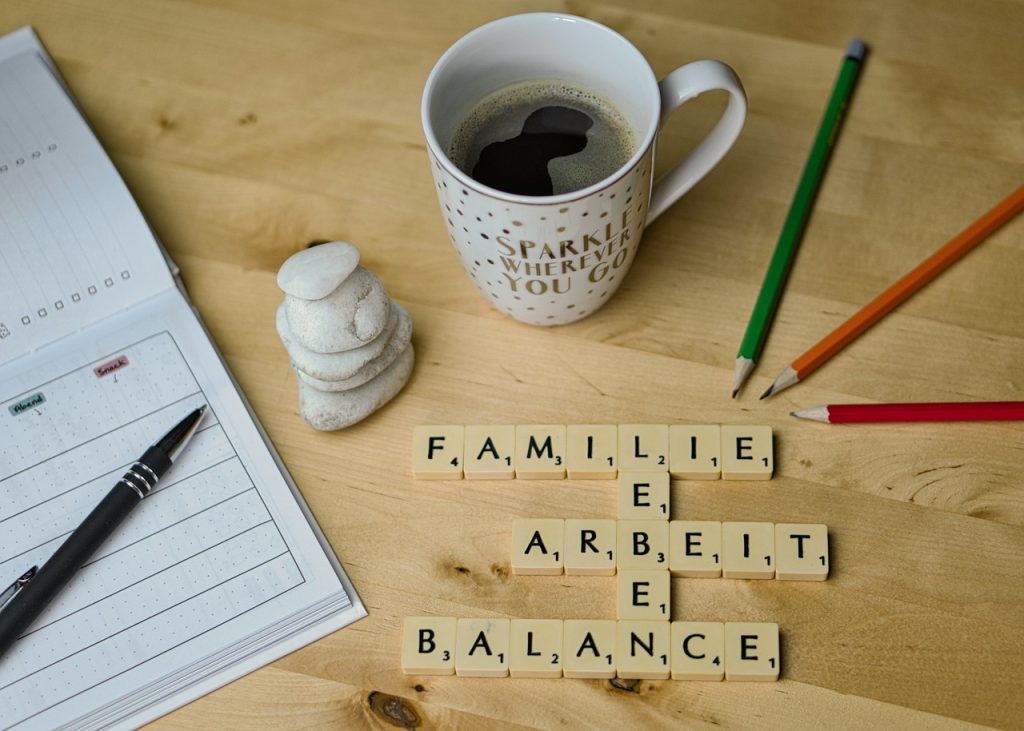Lifestyle
Balancing Act: Managing Work-Life Harmony
Work-life harmony is not a destination but a continuous, evolving process. By adhering to the principles outlined in this comprehensive guide and adopting a flexible mindset, professionals can harmonize their work and personal life in ways that contribute to their well-being and overall success.

In the relentless pursuit of professional success, the line between work and personal life is increasingly blurred. With the advent of technology, the traditional 9-to-5 model has given way to a hyper-connected world where the “always-on” culture can disrupt the delicate equilibrium between our professional aspirations and our personal well-being. In that cause, balancing act is very important for every person.
Navigating this delicate balance is not just a matter of time management or structured schedules—it’s about achieving a state of harmony where both spheres of our life complement and support each other. This in-depth guide is your compass to recalibrating the way you approach work and personal life, ensuring they harmonize to create a truly fulfilling existence.
Table of Contents
Introduction
Society often extols the virtues of achieving work-life balance, yet the pursuit of this ideal remains elusive for many. However, by reframing the goal to that of work-life harmony, we invite a perspective that emphasizes integration and synergy rather than strict partitioning. Work-life harmony is about creating a life where both work and personal activities are not only able to coexist but also reinforce each other, leading to a richer, more fulfilling experience.
What is the Balancing Act?
The “balancing act” typically refers to the challenge of managing multiple responsibilities, priorities, or aspects of life in a way that maintains equilibrium and harmony. It implies the need to juggle various commitments, such as work, family, personal pursuits, social life, and self-care, while ensuring that none of these areas become overwhelmingly dominant or neglected. Achieving a balance involves making conscious decisions, setting boundaries, prioritizing tasks, and allocating time and energy effectively to meet different demands without experiencing excessive stress or burnout. It’s about finding a sustainable equilibrium that allows individuals to thrive in all aspects of their lives.
The Evolving Landscape of Work and Life
The modern workplace is a dynamic ecosystem continually shaped by technological advancements, shifting economies, and evolving societal norms. These changes have profound effects on our personal lives, often demanding new approaches to how we manage our time and commitments. Gone are the days when the physical act of leaving the office signaled the end of the workday; the virtual office is now accessible from anywhere, at any time.
For many, this shift has been a double-edged sword, providing unprecedented flexibility and autonomy alongside the potential for perpetual work intrusion. In response, professionals are being called upon to develop a more holistic approach to their well-being, incorporating self-care and leisure into their daily routines, and cultivating an environment where work and life can seamlessly intertwine in productive harmony.
Assessing Personal Values and Priorities
The first step toward work-life harmony is introspection. Understanding what truly matters to you and aligning your daily activities with these core values is essential. Reflecting on your individual values and life goals provides the foundation upon which you can build a balanced approach to work and life. Assessing and reassessing your priorities ensures that the time and energy you invest are in the pursuit of your most meaningful objectives.
Establishing Boundaries in the Digital Age
In a world of constant connectivity, setting boundaries becomes a radical act of self-preservation. The expectation of being reachable at all hours can strain even the most robust work-life commitments. Establishing and, critically, communicating clear boundaries with your employer and colleagues is an assertive step in reclaiming control over your personal time. Furthermore, adopting specific strategies for separating work and personal technology use can create a cognitive distinction that supports a harmonious lifestyle.
Time Management and Productivity
Efficient time management is the linchpin of a balanced life. By employing strategies such as prioritization, goal setting, and the Pomodoro technique, professionals can optimize their schedules to ensure they are making the most of their time. Importantly, integrating regular breaks and leisure activities into daily life is not a concession to productivity; it is a proven method for sustaining high performance over the long term.
The Role of Flexibility in Work Arrangements
The traditional 40-hour workweek is no longer the gold standard. Exploring and negotiating flexible work options can offer significant advantages in the quest for work-life harmony. Remote work, job sharing, and adjusted schedules provide the latitude to manage personal commitments while remaining professionally engaged. Adapting to these new paradigms requires a mindset shift and a commitment to making them work for your unique set of circumstances.
Cultivating a Supportive Work Environment
Workplace culture plays a pivotal role in enabling work-life harmony. An environment that values and supports a balance between work and life encourages open communication and the mutual respect of personal time. By cultivating such a culture, employers can enhance employee satisfaction and retention, while employees feel empowered to bring their full selves to both work and home.
Strategies for Effective Communication
Clear and assertive communication at work is paramount, particularly when it comes to setting expectations and defining boundaries. By mastering the art of assertiveness, professionals can cultivate relationships that respect their time and needs. When conflicts do arise, establishing effective resolution techniques can prevent them from spilling over into your personal life, maintaining the equilibrium vital for harmonious living.
Integrating Personal Wellness into Daily Life
Self-care is not a luxury; it is a necessity for maintaining the energy and focus required to succeed professionally and personally. Prioritizing personal wellness through nutrition, exercise, and mindfulness practices not only supports individual health but also benefits the collective well-being of your work environment. Recognizing the symbiotic relationship between personal wellness and professional success is key to achieving work-life harmony.
Balancing Family and Career Responsibilities
For working parents and caregivers, the challenge of balancing professional duties with family responsibilities is acutely felt. Strategies that involve open communication, flexible work arrangements, and shared responsibilities within the family unit can help alleviate the strain. By fostering a supportive network that respects the roles and needs of each member, the delicate dance of family and career can be performed with greater ease.
Mindfulness and Work-Life Integration
Mindfulness is a powerful tool for cultivating a harmonious relationship with work and life. Incorporating practices that promote present-moment awareness can reduce stress, enhance focus, and foster a greater appreciation for the activities at hand. Through mindfulness, the integration of work and life becomes less about compartmentalization and more about wholehearted engagement.
Recognizing and Overcoming Burnout
Burnout is the antithesis of work-life harmony, signaling an unbridgeable gap between the energy spent on work and the resources left for life. Recognizing the signs of burnout early and implementing strategies to prevent it are critical for maintaining balance. Seeking support from your employer, colleagues, and professional networks can provide the necessary resources to overcome this pervasive challenge.
Success Stories and Lessons Learned
Real-life accounts from individuals who have successfully achieved work-life harmony provide valuable insights and practical tips. By learning from the experiences of others, you can glean new perspectives and approaches to incorporate into your own life. Their stories serve as inspiration, illuminating tangible pathways to a more balanced existence.
Conclusion
Work-life harmony is not a destination but a continuous, evolving process. By adhering to the principles outlined in this comprehensive guide and adopting a flexible mindset, professionals can harmonize their work and personal life in ways that contribute to their well-being and overall success. The key is not in the pursuit of perfect balance but in the willingness to adjust, adapt, and make conscious choices that honor the multifaceted aspects of our humanity.
In the ceaseless juggle of professional and personal commitments, remember that it is your conscious actions and choices that will lead to a harmonious and pleasurable life. By recognizing the importance of work-life harmony and taking active steps to achieve it, you pave the way for a more fulfilling and sustainable future.
Video : 3 rules for better work-life balance
Lifestyle
How to Improve Egg Quality for Fertility: Science, Lifestyle and Expert Tips

Improving egg quality is a major goal for many individuals and couples trying to conceive—whether naturally or through assisted reproductive technologies (ART) like IVF. While age is the most well-known factor impacting fertility, growing evidence suggests that lifestyle changes can significantly support egg health.
🧬 What Does “Egg Quality” Actually Mean?
Egg quality refers to the likelihood that an egg will be fertilized and develop into a healthy embryo. It’s determined by two major factors:
- Chromosomal Normality (Aneuploidy Risk)
A high-quality egg has the correct number of chromosomes. As you age, the chances of chromosomal abnormalities in eggs increase, which can lead to miscarriage or failed implantation. - Mitochondrial Health
Mitochondria are the energy powerhouses of a cell. In eggs, they provide the energy needed for fertilization, cell division, and early embryo development. Low mitochondrial function often equals poor egg viability.
⏳ Age and Egg Quality: What You Should Know
Egg quality naturally declines with age:
- After age 30: Decline begins gradually
- After 35: Decline accelerates
- After 40: Risk of chromosomal abnormalities increases sharply
However, age isn’t the only factor. Environmental toxins, chronic stress, poor diet, and lack of sleep can also negatively affect egg health—regardless of age.
🚫 Common Habits That Harm Egg Quality
To improve egg health, it’s crucial to first understand what damages it:
Habit Impact on Egg Health Smoking/Vaping Depletes ovarian reserve and increases oxidative stress Excessive Alcohol Impairs liver detox and hormone metabolism Poor Sleep Disrupts hormonal cycles and cellular repair High Sugar Diet Leads to insulin resistance and hormonal imbalances Chronic Stress Elevates cortisol and disrupts ovulation Exposure to Plastics Chemicals like BPA and phthalates act as endocrine disruptors
🥗 Best Foods to Improve Egg Quality Naturally
A fertility-boosting diet can reduce inflammation, optimize hormone production, and improve cellular health.
✅ Fertility Superfoods:
- Leafy Greens (spinach, kale): High in folate, iron, magnesium
- Avocados: Healthy fats, vitamin E, and antioxidants
- Salmon: Rich in omega-3s and selenium
- Blueberries & Berries: Powerful antioxidants that fight free radicals
- Eggs (especially pasture-raised): Contain choline and fat-soluble vitamins
- Lentils and Chickpeas: Great plant-based sources of iron and protein
- Brazil Nuts: Loaded with selenium, which protects eggs from oxidative stress
🧃 Foods to Avoid:
- Trans fats (found in packaged baked goods)
- Processed meats (contain nitrates and inflammatory agents)
- Refined carbs and sugars (increase insulin resistance)
- Soda and sugary beverages
6 Science-Backed Ways to Improve Egg Quality
1. Optimize Your Diet for Fertility
What the Research Says:
- A Mediterranean diet (rich in olive oil, fish, nuts, and vegetables) is linked to better IVF outcomes.
- Antioxidants (vitamins C, E, selenium) reduce oxidative stress, which damages eggs.
- Omega-3s (from salmon, chia seeds, walnuts) improve egg membrane health.
Foods to Focus On:
✅ Leafy greens (spinach, kale – high in folate)
✅ Berries (blueberries, raspberries – packed with antioxidants)
✅ Wild-caught salmon (omega-3s + vitamin D)
✅ Eggs (choline supports fetal development)
✅ Brazil nuts (selenium for egg maturation)
Foods to Avoid:
❌ Trans fats (fried foods, processed snacks)
❌ Excess sugar (disrupts hormone balance)
❌ High-mercury fish (swordfish, king mackerel)
2. Reduce Oxidative Stress & Inflammation
Oxidative stress damages egg cells over time. Ways to combat it:
Key Strategies:
✔ Exercise moderately – Intense workouts increase oxidative stress, but gentle movement (yoga, walking) helps.
✔ Prioritize sleep – Poor sleep raises cortisol, which may harm egg quality. Aim for 7–9 hours.
✔ Quit smoking – Toxins in cigarettes accelerate egg aging.
✔ Limit alcohol & caffeine – More than 1 drink/day or 200mg caffeine may impact fertility.
3. Support Mitochondrial Health
Mitochondria are the “batteries” of your eggs. As you age, they become less efficient.
How to Boost Mitochondrial Function:
- CoQ10 supplements (100–600mg/day) – Shown in studies to improve egg quality in IVF patients.
- Acupuncture – May enhance blood flow to ovaries (some studies suggest benefits).
- Intermittent fasting (under medical guidance) – Some research suggests it may help cellular repair.
4. Detoxify Your Environment
Everyday toxins can disrupt hormones and harm egg health.
Top Toxins to Avoid:
- BPA & phthalates (in plastics, receipts, canned foods) – Use glass containers instead.
- Parabens & synthetic fragrances (in cosmetics) – Switch to clean beauty products.
- Pesticides – Choose organic produce when possible (especially the “Dirty Dozen”).
5. Manage Stress & Balance Hormones
Chronic stress raises cortisol, which can interfere with ovulation.
Stress-Reduction Techniques:
- Mindfulness meditation (just 10 mins/day helps)
- Fertility yoga (poses like “legs up the wall” improve pelvic blood flow)
- Adaptogenic herbs (like ashwagandha – but check with your doctor first)
6. Consider Fertility-Boosting Supplements
Always consult a doctor before starting supplements.
Most Recommended:
- Prenatal vitamin (with methylfolate, not folic acid)
- CoQ10 (Ubiquinol form) – 200–400mg/day
- Myo-inositol – Especially helpful for PCOS (improves insulin sensitivity)
- Vitamin D – Low levels are linked to infertility (aim for 40–60 ng/mL)
💊 Supplements That Support Egg Health
Before taking any supplement, consult with a doctor or fertility specialist. However, the following nutrients have shown promising results in supporting egg quality:
1. CoQ10 (Ubiquinol Form)
Improves mitochondrial function, especially in women over 35. Studies show improved egg maturation and embryo quality.
2. Omega-3 Fatty Acids
Anti-inflammatory properties that support hormone balance and improve cervical mucus.
3. Vitamin D
Essential for ovulation and egg maturation. Many women are deficient.
4. Myo-Inositol
Great for women with PCOS. Improves insulin sensitivity and ovarian function.
5. N-Acetyl Cysteine (NAC)
An antioxidant that helps detoxify the liver and reduce inflammation.
6. Folic Acid / Methylfolate
Supports DNA replication and embryo development.
📆 Egg Quality Timeline: Why 3 Months Matters
Eggs take approximately 90 days to mature before they are ovulated. This means the actions you take today—diet, lifestyle, supplements—impact the eggs you’ll ovulate in the coming months.
That’s why most fertility specialists recommend committing to lifestyle changes at least 3 months before trying to conceive, especially if going through IVF or egg freezing.
👩⚕️ What If You’re Over 35 or Facing Fertility Issues?
Age isn’t everything. Plenty of women conceive in their late 30s or even 40s. However, if you’re over 35 and have been trying for 6+ months (or under 35 and trying for 12+ months), it may be time to consult a fertility specialist.
A fertility specialist can:
- Run hormone and egg reserve tests (AMH, FSH, estradiol)
- Conduct ultrasounds for antral follicle counts
- Recommend treatments such as IVF, IUI, or egg retrieval
- Create a personalized supplementation and lifestyle plan
👶 Can Egg Quality Be Improved?
While egg quantity (how many eggs you have left) is mostly determined by age and genetics, egg quality is more adaptable.
You can’t reverse aging, but you can:
✅ Reduce oxidative stress
✅ Improve mitochondrial energy
✅ Enhance blood flow to ovaries
✅ Support hormonal balance
✅ Create a healthier environment for eggs to thrive
✅ Final Thoughts: Supporting Egg Quality Naturally
Improving egg quality is not an overnight fix—but it is within your control. A holistic approach that includes nutrition, lifestyle, sleep, and stress management can go a long way in supporting your fertility.
Remember: Your reproductive health reflects your overall health. By caring for your body, you’re also protecting your future fertility.
Egg Quality: How To Improve Your Egg Quality from Youtube
5 Tips to Improve Egg Quality: What Lifestyle Changes are Recommended for Your Fertility?
Lifestyle
When Is It Time To Get a Divorce? Emotional, Mental & Practical Signs to Know

Making the decision to leave a marriage is one of the most emotionally intense and deeply personal choices anyone can face. For many, the idea of divorce brings with it a flood of conflicting feelings — guilt, fear, confusion, sadness, and sometimes, even relief.
But how do you really know when it’s time to get a divorce? What separates a rough patch from a permanent incompatibility? And when is staying in a marriage doing more harm than good?
Let’s explore the expert-backed signs, emotional red flags, and practical considerations that can help guide you through this life-changing decision.
💔 Why Deciding to Divorce Is So Emotionally Complex
Deciding to end a marriage isn’t just a legal or financial decision — it’s an emotional transformation. According to licensed psychotherapist Dr. Tracy Ross, many people delay divorce not because they’re happy, but because the unknown feels scarier than staying stuck.
“People can live in a state of limbo for years, afraid to take a step in either direction,” she says.
Fear of change, concern for children, financial dependency, and social stigma all play a role in why people stay in unhappy marriages far longer than they should.
🔥 Emotional Burnout: One of the Strongest Signs It May Be Time
Relationship burnout is a real psychological state, and it often signals the emotional end of a marriage. This goes beyond ordinary frustration or conflict — it’s the feeling of being emotionally depleted, chronically exhausted, and mentally checked out.
Signs of emotional burnout in a marriage may include:
- Feeling completely indifferent toward your partner’s thoughts or actions
- Avoiding time together at all costs
- A deep sense of loneliness, even while cohabitating
- Apathy about the marriage’s future
- Constant daydreaming about starting over alone
If you’ve reached the point where you feel there’s nothing left to say, nothing left to fight for, and nothing left to hope for — it may be time to start exploring a way out.
⚠️ Major Red Flags That Often Precede Divorce
Not all marriages are salvageable. In fact, some situations are simply too toxic or harmful to stay in. If your marriage includes any of the following, experts agree that divorce should seriously be considered:
🚩 1. Emotional or Physical Abuse
Abuse — whether physical, verbal, or emotional — is never acceptable. Staying in an abusive relationship can damage your mental health, self-worth, and safety.
🚩 2. Chronic Disrespect or Contempt
When one or both partners regularly express disdain, sarcasm, name-calling, or eye-rolling, this behavior erodes the foundation of trust and mutual respect.
🚩 3. Complete Communication Breakdown
Occasional communication issues are normal, but total communication shutdown is a strong indicator that connection and intimacy have died.
🚩 4. Repeated Betrayals
Whether it’s infidelity, financial secrets, or broken promises, repeated betrayals can be impossible to recover from without mutual commitment to rebuild.
🚩 5. Lack of Emotional or Physical Intimacy
Intimacy — not just sex, but emotional closeness — is essential in a healthy marriage. If it’s gone and efforts to revive it have failed, it may be time to consider moving on.
🤝 When Marriage Counseling Isn’t Enough
Marriage counseling is a powerful tool, but it requires both partners to be engaged. If one partner is checked out, abusive, or manipulative, therapy may not work.
“Therapy can’t fix a relationship where only one person wants change,” says Dr. Nikki Martinez, a licensed psychologist.
If you’ve tried couples therapy and still feel stuck, it might be a sign that the relationship has reached its end.
💬 Questions to Ask Yourself Before Making a Decision
Before filing for divorce, it helps to engage in self-reflection. Here are some expert-recommended questions to ask yourself:
- Am I staying in this marriage out of love, or fear of being alone?
- Have I communicated my needs clearly and honestly?
- Is my partner willing to meet me halfway?
- Am I emotionally or physically unsafe?
- How would my life look if I stayed like this for the next 5 or 10 years?
These questions can help you determine whether your marriage can be repaired — or whether it’s time to let go.
💼 The Practical Side of Divorce: What to Prepare For
If you’ve made the decision to move forward with divorce, preparation is key. Here are some practical steps to consider:
- Seek legal counsel: Understand your rights and obligations.
- Get financial clarity: Know your assets, debts, and income sources.
- Plan for children (if applicable): Work toward a co-parenting plan that puts their needs first.
- Find emotional support: Whether therapy, support groups, or close friends, don’t walk through this process alone.
- Protect your mental health: Divorce is emotionally taxing, and self-care is non-negotiable.
🧠 Mental Health Matters: Divorce Can Be the Beginning, Not the End
Divorce isn’t a failure — it can be a conscious choice for growth, healing, and peace. In fact, many people report better mental health, emotional clarity, and a renewed sense of purpose after divorce.
“It’s OK to choose your own peace, even if others don’t understand it,” says Dr. Ross.
Sometimes, walking away is the bravest and most loving decision you can make — for yourself and your future.
📝 Final Thoughts: Trust Yourself, Even If It’s Scary
Choosing to end a marriage is rarely black and white. It’s a process filled with emotion, self-reflection, and uncertainty. But if you’ve reached a place where staying is more painful than leaving, you owe it to yourself to explore your options.
You don’t have to rush, but you also don’t have to stay stuck.
Trust your inner voice. Protect your peace. And know that healing — while not easy — is always possible.
Lifestyle
Financial Well-Being: Building a Healthy Relationship with Money
In the intricate tapestry of life, our relationship with money is a thread that weaves through every aspect of our existence. Whether we acknowledge it or not, the way we handle, think about, and interact with money has a profound impact on our well-being.
In the intricate tapestry of life, our relationship with money is a thread that weaves through every aspect of our existence. Whether we acknowledge it or not, the way we handle, think about, and interact with money has a profound impact on our well-being. Understanding this connection is pivotal for anyone seeking a balanced and prosperous life. But where do we begin to untangle the complexities of our financial life and forge a path to true financial well-being? This comprehensive guide is designed to walk you through the phases of this personal financial odyssey.

Table of Contents
I. Introduction
Navigating the seas of personal finance can be daunting, but it’s a quest that’s worthy of every minute invested. Financial well-being encompasses more than just having a robust bank account; it speaks to the peace of mind that comes from knowing you’re equipped to handle the challenges life throws your way.
Defining Financial Well-Being
At its core, financial well-being is the state of being comfortable, happy, and prosperous due to one’s financial situation. It signifies the ability to meet current and ongoing financial obligations, feel secure in one’s financial future, and make choices that allow enjoyment of life.
Recognizing the Impact of Money on Overall Health
The links between financial and physical health are undeniable. Chronic stress related to financial strains can raise blood pressure, contribute to heart disease, and even reduce immune function.
The Connection Between Financial Literacy and Well-Being
A key foundation of good money management is financial literacy. The more knowledgeable we are about managing our finances, the better we can work towards financial health and well-being.
II. Assessing Current Financial Health
To chart a course toward financial well-being, you need to understand your current position. It’s akin to a health check-up, but for your money.
Understanding Personal Financial Goals
Your life’s goals and aspirations are unique, and they should guide your financial plan. These could range from everyday wants to more significant life achievements like owning a home or ensuring a comfortable retirement.
Evaluating Income, Expenses, and Debt
Income, expenses, and debt are the three pillars of personal finance. Conduct an honest assessment to ascertain how you’re faring in managing these aspects of your financial life.
The Importance of Regular Financial Check-ins
Take time for regular ‘financial health’ check-ups to ensure you’re on track. Doing so allows you to make adjustments as your life circumstances and priorities change.
III. Establishing a Clear Budget and Financial Plan
A budget is your financial blueprint; it helps your money work for you rather than the other way around.
Creating a Realistic Monthly Budget
A budget that’s both detailed and attainable is a powerful tool. It helps rein in spending, save for future goals, and even provide a sense of control in a world that’s often financially unpredictable.
Setting Short-Term and Long-Term Financial Goals
Tangible, achievable, and time-bound goals keep you motivated. Whether it’s a vacation fund or a down payment for a house, linking specific goals to your budget ensures they’re given the priority they deserve.
Developing Strategies for Saving and Investing
Savings and investments are the engines that drive financial growth. Choose the right strategies that align with your risk tolerance and financial goals.
IV. Building Emergency Funds and Financial Cushions
An emergency fund is the first line of defense in your financial arsenal. It stands between you and life’s inevitable financial curveballs.
The Importance of Emergency Savings
An emergency fund prevents you from sliding into debt when unexpected expenses arise. It brings a measure of stability and security to your financial life.
Strategies for Building and Maintaining Financial Cushions
Consider these highly manageable methods to consistently build and maintain your emergency fund, without straining your monthly budget.
Preparing for Unforeseen Financial Challenges
Prepare for worst-case scenarios by implementing insurance strategies that protect your assets and your family in times of need.
V. Understanding Credit and Debt Management
Credit and debt can be double-edged swords. When handled well, they can be powerful allies in your financial growth.
Navigating the World of Credit Scores
Your credit score is a financial report card. Understand how it’s calculated and the factors that influence it.
Responsible Credit Card Use and Management
Credit cards offer convenience and perks, but also carry risks. Learn how to wield them responsibly to avoid costly pitfalls.
Strategies for Effective Debt Repayment
From the high-interest snowball method to the broad-finished-quick approach, there are several strategies you can employ to tackle debt smartly and systematically.
VI. Investing in Financial Education
In a world where financial products are more complex than ever, education is the key to sound financial decision-making.
The Role of Continuous Learning in Financial Literacy
Lifelong learning is just as important in finance as it is in any other field. Stay abreast of financial news and trends to make informed decisions.
Resources for Improving Financial Knowledge
From traditional classes to online platforms, there are a wealth of resources to improve your financial literacy.
Seeking Professional Advice for Complex Financial Situations
Sometimes, situations are too complex for a DIY approach. Financial professionals can provide invaluable support and expertise.
VII. Creating Multiple Income Streams
Diversifying your income can provide stability against job loss and a means to reach financial goals more expediently.
Diversifying Income Sources for Stability
Explore different income streams, such as freelance work, rental properties, or passive income, to spread out your financial risk.
Exploring Passive Income Opportunities
Passive income is money that keeps coming in without you having to actively work for it. Here are some popular passive income ideas you can explore.
Balancing Multiple Income Streams for Financial Security
Ensure you have a balance between your primary income, your side ventures, and your investments. Each should contribute to a holistic financial strategy.
VIII. Mindful Spending and Consumer Choices
Our consumption patterns have direct implications on our financial state. Mindful spending can lead to more conscious financial management.
Practicing Conscious Consumerism
Be deliberate with your spending. Understand the impact of every purchase and make choices that align with your values and financial goals.
Differentiating Between Needs and Wants
The age-old mantra of ‘knowing the difference’ holds true. Prioritize needs over wants, and strive to create a spending environment that acknowledges that distinction.
Overcoming Impulse Buying and Emotional Spending
Impulse buying is often driven by emotion. Develop strategies to manage these triggers and take control of your purchasing decisions.
IX. Building a Sustainable and Responsible Financial Lifestyle
Today’s consumer has a myriad of choices, many of which can have wider ethical and environmental implications.
Prioritizing Sustainable and Ethical Investments
Your money can be a powerful tool for good. Explore sustainable and ethical investment options that align with your values.
Eco-Friendly and Socially Responsible Spending Habits
Your spending habits also reflect on your values. Opt for eco-friendly and ethically manufactured products and services where possible.
The Intersection Between Financial and Environmental Well-being
Recognize the interconnectedness of financial and environmental health. Building a greener lifestyle has the potential to save money and the planet simultaneously.
X. Financial Planning for Life Milestones
Life doesn’t stand still, and neither should your finances. Plan ahead for significant life events to ensure you’re financially prepared.
Saving for Education and Career Transitions
Whether it’s furthering your education or navigating a career shift, robust financial planning makes these transitions smoother.
Planning for Homeownership and Real Estate Investments
Homeownership often involves the largest purchase in one’s life. Understand the financial implications and planning strategies involved.
Retirement Planning and Long-Term Financial Security
Even though retirement may seem distant, it’s never too early to start planning. In fact, the earlier, the better due to the power of compound interest.
XI. Managing Financial Stress and Anxiety
Money worries can be all-consuming, but there are practical strategies to manage and alleviate this stress.
Identifying and Addressing Sources of Financial Stress
Pinpoint the specific financial stressors in your life. Once identified, you can take targeted action to address them.
Coping Strategies for Financial Anxiety
From visualization techniques to stress-relief activities, these coping strategies can help you manage financial-related anxiety.
The Connection Between Mental Health and Financial Well-being
Mental health and financial well-being are deeply interlinked. Taking care of your mental health can, in turn, positively impact your financial life.
XII. Open Communication About Finances in Relationships
Money is often a taboo topic, yet open communication is essential, especially in relationships.
Navigating Financial Discussions with Partners
Honest and open dialogues with your partner about finances can strengthen your relationship and can lead to aligned financial goals.
Establishing Shared Financial Goals and Plans
When partners share common financial goals, their combined efforts can achieve remarkable results.
Strategies for Resolving Financial Conflicts in Relationships
Conflicts are inevitable, but they can be resolved. Employ strategies such as compromise and professional mediation for a healthier financial foundation in your relationship.
XIII. Building a Healthy Financial Mindset
Your beliefs and attitudes towards money shape your financial reality. Transforming your mindset is a crucial step in achieving true financial well-being.
Shifting from Scarcity to Abundance Thinking
Adopt an abundance mindset. This shift in perspective can open you up to new opportunities and a more fulfilled financial life.
Cultivating Gratitude for Financial Resources
Gratitude is a powerful force. Cultivate it for the financial blessings in your life, no matter how small.
The Impact of Mindset on Financial Decision-Making
Your mindset directly influences the decisions you make with money. Understand this connection to make more conscious and empowering choices.
XIV. Success Stories and Financial Transformations
Real-life stories of success and transformation can be incredibly motivating. They serve as testaments to the principles explored in this guide.
Real-life Experiences of Financial Success
Read about individuals who have taken control of their financial destinies and achieved remarkable success.
Positive Changes in Lifestyle and Well-being
Explore the non-financial benefits experienced by those who have improved their financial well-being.
Practical Tips and Lessons Learned from Financial Journeys
Extract the practical tips and lessons from these stories to apply to your own financial voyage.
XV. The Evolution of Financial Well-Being
Financial well-being is not a destination, it’s a continuous evolution. Keep the momentum going and adapt to the changes life brings.
Embracing Ongoing Financial Growth
Stay committed to your financial education and personal development. It’s a lifelong process that rewards persistence.
Adapting to Changing Economic Landscapes
Economies are in a state of constant flux. Develop the skills to adapt and thrive in any financial environment.
Inspiring a Community of Financially Empowered Individuals
Share your knowledge and experiences to build a community of individuals who take control of their financial well-being.
XVI. Conclusion
In conclusion, money doesn’t have to be a source of stress in life. By building healthy financial habits, fostering a positive relationship with money, and continuously educating ourselves, we can all achieve a state of financial well-being that supports a fulfilling and prosperous life.
But remember, this path is not one to be traveled alone. Seek out mentors, financial planners, and a supportive community to walk alongside you. Together, we can redefine our relationship with money and live life to its fullest.
-

 Personal Care7 months ago
Personal Care7 months agoWhy Regular Massages Could Be the Game-Changer Your Body and Mind Crave
-

 Mental Health7 months ago
Mental Health7 months agoHow to Overcome Phobias: 15 Positive Psychology-Based Strategies That Really Work
-

 Lifestyle7 months ago
Lifestyle7 months agoWhen Is It Time To Get a Divorce? Emotional, Mental & Practical Signs to Know
-

 Fitness7 months ago
Fitness7 months ago6 Quick Morning Exercises to Burn Belly Fat All Day
-

 Mental Health7 months ago
Mental Health7 months agoWhat Is A Depression Attack? Symptoms, Causes & How To Cope With One
-

 Lifestyle7 months ago
Lifestyle7 months agoHow to Improve Egg Quality for Fertility: Science, Lifestyle and Expert Tips
-

 Food7 months ago
Food7 months agoHealthy Rice Varieties: Nutrition and Health Benefits
-

 Personal Care7 months ago
Personal Care7 months agoHow to Reparent Your Inner Child: Healing and Self-Compassion







